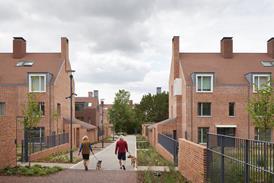Can the Bacon Report make self-building less scary? Grand Designs will never be the same, says David Rudlin

Last year, in a presentation on the National Model Design Code I used a personal example of the Bordeaux suburb of Mérignac. For 20 years we spent our summers there at the house of my wife’s cousin Cécile. She and her partner had bought two “flag plots”. I didn’t know the term either, but a French colleague explained that these are plots in the centre of a block accessed by a track between two frontage plots.
They had built their own home on one of the plots and the other was a massive garden. At one point we broached the idea of building a house on the vacant plot, but it was explained that this was a non-starter – not because anyone thought it a bad idea you understand – but because the Floor Area Ratio for the block had been met and, in a non-discretionary planning system, that was that. This was my message on design codes; they created certainty but not always the right outcome.
However my story is also relevant to the Bacon Review published last week following a request from the prime minister to recommend ways of scaling up self-build and custom housebuilding. Richard Bacon’s report includes six recommendations, of which more in a moment. It also opens with a quote from my recent book but I won’t let that sway me!
The point of the Mérignac story is not that we couldn’t self-develop but that almost every other household had done so. This was a typical suburb and these people were not doing anything out of the ordinary. As Bacon says, on average 40% of new housing in most European countries is self-developed. This would translate to 120,000 homes a year in the UK compared to our current figure of around 13,000.
The aim of the Bacon Review is to transform this situation. While the early chapters cover familiar ground, he finds some nicely turned phrases: Housing is the “new pollution” and if new homes were cars they would be “Trabants”. With an eye on his conservative colleagues he suggests that, if people aren’t given a stake in capitalism by developing their own home, don’t be surprised if they turn to socialism.
He concludes that there is just as much appetite for self-development in the UK as there is elsewhere. It is just that the system is so stacked against the self-builder that only intrepid souls willing to risk everything can live the dream – a point reinforced by the narrative arc of every Grand Designs episode. In France and elsewhere there is a whole industry catering to self-development, the market makes land and finance available and zonal planning systems de-risk the process of getting permission.
The question is whether Bacon’s recommendations can really bring about the scale of change he wants. After all, it is 10 years since the government’s housing strategy set out to do something similar (within a decade). Since then we have had the “Right to Build”, changes to planning and taxation policy, the Custom Build Homes Fund and the Self-build and Custom Housebuilding Act. Every year there has been some government initiative including the “Self- and Custom-Build Action Plan” earlier this year. And yet the number of self-developed homes in the UK has risen only marginally.
Bacon recognises this and focuses his recommendations on land supply with a major role for Homes England to act as a master developer bringing forward serviced plots, providing financial support and borrowing. He suggests a custom and self-build “show park” to raise awareness and to make it all look less scary, as well as support for community self-builders and rental schemes.
>> Also read: Building Study: Marmalade Lane, Cambridge, by Mole Architects
>> Gillian Darley: The communities where neighbourliness is part of the design
He recommends a planning designation for custom and self-build that replicates a zonal system and a series of tax changes. The route map, as he calls it, sees these measures as a catalyst to kick-start the market so that attitudes will change, markets will respond, the number of small builders will grow, and financial institutions will create new products.
I really hope that it will work, and there is much common sense here. But whether it adds up to a revolution remains to be seen. To paraphrase the old joke, the route map may be good, but I wouldn’t have started from here!
















1 Readers' comment